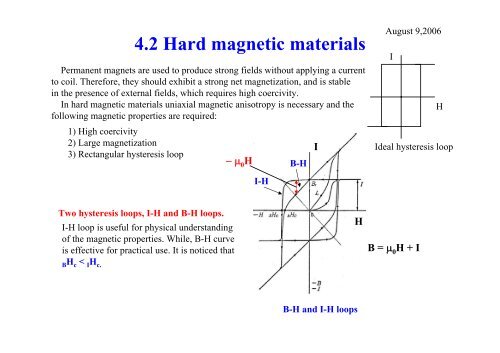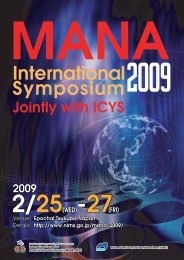4.2 Hard magnetic materials
4.2 Hard magnetic materials
4.2 Hard magnetic materials
You also want an ePaper? Increase the reach of your titles
YUMPU automatically turns print PDFs into web optimized ePapers that Google loves.
<strong>4.2</strong> <strong>Hard</strong> <strong>magnetic</strong> <strong>materials</strong><br />
Permanent magnets are used to produce strong fields without applying a current<br />
to coil. Therefore, they should exhibit a strong net magnetization, and is stable<br />
in the presence of external fields, which requires high coercivity.<br />
In hard <strong>magnetic</strong> <strong>materials</strong> uniaxial <strong>magnetic</strong> anisotropy is necessary and the<br />
following <strong>magnetic</strong> properties are required:<br />
1) High coercivity<br />
2) Large magnetization<br />
I<br />
3) Rectangular hysteresis loop<br />
−μ 0<br />
H B-H<br />
August 9,2006<br />
I<br />
H<br />
Ideal hysteresis loop<br />
I-H<br />
Two hysteresis loops, I-H and B-H loops.<br />
I-H loop is useful for physical understanding<br />
of the <strong>magnetic</strong> properties. While, B-H curve<br />
is effective for practical use. It is noticed that<br />
B H c < I H c.<br />
H<br />
B = μ 0<br />
H + I<br />
B-H and I-H loops
Maximum energy products (BH) max<br />
Load lines<br />
The form of the hysteresis loop is very sensitive to sample shape<br />
due to the demagnetization factor. When permanent magnets are<br />
used in open circuit, their technical properties are strong functions<br />
of the magnet shape.Thus, it is important to distinguish between<br />
intrinsic or extrinsic.<br />
The magnets are practically used at the the point on the secondquadrant<br />
branch. The load line has a slope given by –(1-N)/N,<br />
where N is the demagnetization factor. This line intersects the<br />
B – H curve at the point, which indicates the remanence actually<br />
achieved in a given shape having average demagnetization factor N.<br />
Load line<br />
Maximum energy point<br />
The maximum energy density of a permanent magnet (BH) max is<br />
determined by the point on the second-quadrant branch of the B-H<br />
loop, which gives the largest area for an enclosed rectangle.The<br />
location of (BH) max is the point at which the material characteristics<br />
of a magnet are most efficiently used.<br />
Theoretical (BH) max is given by (I s<br />
2<br />
/4μ 0 ) on the condition of<br />
I H C > I s /2.<br />
(BH) max point<br />
H
Ideal hysteresis loop<br />
I-H<br />
Ι<br />
I s<br />
B-H<br />
(BH) max<br />
I s<br />
/2<br />
B=μ 0 H + I<br />
45<br />
μ 0 I<br />
H C μ 0 B<br />
H C<br />
Theoretical<br />
μ 0<br />
I s<br />
/2<br />
0<br />
μ 0<br />
H<br />
I H C = μ 0 I s /2<br />
(BH)max = (I s<br />
/2) (I s<br />
/2μ 0<br />
) = I s2<br />
/4μ 0<br />
where μ 0<br />
H > I s<br />
/2
Coercivity and hysteresis loops<br />
Single domain structure<br />
Multi-domain structure<br />
Reversed domain nucleation<br />
Ideal<br />
I<br />
H<br />
Domain wall pinning<br />
Position (x)
Permanent magnet development<br />
500<br />
60<br />
World record<br />
400<br />
Nd-Fe-B<br />
Pt-Fe/Fe<br />
50<br />
(BH) max<br />
=460kJm -3<br />
(57.6MGOe)<br />
for NdFeB magnets<br />
(BH)max / kJm -3<br />
300<br />
200<br />
100<br />
KS-Steel<br />
R-T magnets<br />
Sm(CoFeCuZr) 7.3<br />
Sm(CoFeCu) 7<br />
Alnico<br />
MK<br />
SmCo 5<br />
OP<br />
Pt-Co<br />
BaO 6Fe 2 O 3<br />
Pt-Fe<br />
Sm-Fe-N<br />
(Bonded)<br />
Fe-Cr-Co-Mo<br />
Mn-Al-C<br />
Fe-Cr-Co<br />
0<br />
1900 1920 1940 1960<br />
year<br />
1980 2000<br />
40<br />
30<br />
20<br />
10<br />
0<br />
(BH)max / MGOe
Magnetic hysteresis curves for typical<br />
permanent magnets<br />
I<br />
I<br />
All of the magnets are not formed by a single pahse but multi-phases, which is mainly<br />
due to the controlling of the grain size and/or enhancing the domain wall pinning.
Magnetic properties for various permanent magnet alloys<br />
Material Saturation Anisotropy Anisotropy Curie (BH) max Single<br />
magnetization energy field temperature domain<br />
I S K u H K T C size r c<br />
J/m 3 A/m kJ/m 3 ) (μm)<br />
SmCo 5 1.1 1.5 x 10 7 2.3 x 10 7 725 240 1.7<br />
Sm 2 Co 17 1.28 3.2 x 10 6 5.6 x 10 6 926 326 0.6<br />
Nd 2 Fe 14 B 1.6 4.3 x 10 6 5.3 x 10 6 320 510 0.3<br />
Ba-Ferrite 0.48 3.3 x 10 5 1.1 x 10 5 450 39<br />
Theory (I s<br />
2<br />
/4μ 0<br />
)<br />
r c<br />
= 9γμ 0<br />
/2I s<br />
2
Magnet fabrication processes<br />
Sintering magnets<br />
Casting magnets<br />
Bonded magnets
Various magnets<br />
1. Alnico : Single domain, Shape anisotropy, good thermal stability<br />
Spinodal decomposition<br />
Fe 2 NiAl<br />
Fe-rich α phase<br />
NiAl-rich α’ phase<br />
850 2h then quenching<br />
Fe x Co 1-x NiAl<br />
Coercivity by shape anisotropy<br />
Hc<br />
∝ ΔI( N −N<br />
)<br />
Δ I = I −I<br />
α<br />
2 1<br />
α '<br />
N: demagnetization factor
Anisotropic Alnico magnets<br />
Alnico 8 DG Orientated particles<br />
View H<br />
8009h in a <strong>magnetic</strong> field<br />
H<br />
View // H
2. Hexagonal Ferrites<br />
Single domain particle, Nucleation type<br />
<strong>Hard</strong> ferrites are cheap and light in weight, and thus used for<br />
where energy per unit weight and cost are important conditions.<br />
The hexagonal ferrites based on BaO 6[Fe 2 O 3 ] have the<br />
magnetoplumbite structure as shown below, which is given the<br />
notation BaM and includes PbM and SrM. The hexagonal ferrites<br />
have a strong uniaxial anisotropy, K u = 310 5 J/m 3 with easy axis<br />
along the c axis and small magetization of 0.4 – 0.5 T.<br />
Magnetoplumbite structure
The coercivity of the hexagonal ferrites is limitted by nucleation; once a domain wall exists in a<br />
particle, it moves with ease through the particle under an applied field. However, wall motion<br />
does not appear to propagate from grain to grain. Thus, the coercivity of hexagonal ferrites can<br />
be described by the mechanism of single-domain particle magnetization with the magnetocrystalline<br />
anisotropy.<br />
Commercial ferrite magnets<br />
I (mT)<br />
400<br />
200<br />
0<br />
SW: Stoner-Wohlfarth model<br />
K 1 = 3.4610 5 J/m 3<br />
1.2: Anisotropic magnets<br />
3: Isotropic magnet
Magnetic properties of R-T intermetallics<br />
3. R-T magnets<br />
Effective <strong>magnetic</strong> moments of rare earth metals are<br />
given by μeff<br />
= gμB<br />
. J( J + 1)<br />
For less than half J = L –S<br />
For more than half J = L + S<br />
Exchange coupling of R and T atoms<br />
Antiferro<strong>magnetic</strong> coupling<br />
between T and R spins.<br />
I s<br />
T c
R-T compounds<br />
R-T compounds with high K u and high T c<br />
R 2 T 17<br />
RT 5<br />
Hexagonal<br />
R 2 T 17<br />
= 3(RT 5 )<br />
-R + 2T<br />
Fe dumb-bell site<br />
In R 2 Fe 17<br />
Reduce T C<br />
Rhombohedral
SmCo 5 magnets<br />
SmCo 5 has a very large magnetocrystalline<br />
anisotropy of 10 7 J/m 3 . This magnet exhibits<br />
nucleation type coercivity.<br />
Liquid phase sintering<br />
Sm-Co magnets<br />
Sm 2 Co 17 type magnets<br />
Rhombohedral 2-17 phase has a lower<br />
anisotropy than the 1-5 phase, heat treatment<br />
and inclusion of non<strong>magnetic</strong> atoms such as<br />
Cu and Zr to promote optimal phase segregation<br />
are generally used to achieve higher coercivity<br />
due to the domain wall pinning Thus, 2-17<br />
magnets are called as precipitation hardened magnets.<br />
2-17<br />
1-5 (thickness 10 nm)<br />
I s<br />
(T)<br />
Cell structure
Crystalline structure of R 2 Fe 14 B<br />
NdFeB magnets<br />
I-T curves for R 2 Fe 14 B<br />
s I<br />
Nucleation type magnets<br />
Magnetization reversal in sintered 2-14-1 magnets<br />
occurs by nucleation and growth of reversal domains.<br />
According to Kronmuller the coercivity is given by<br />
2Ku<br />
IHC = aKa eff<br />
Ψ<br />
−N I<br />
Is<br />
Here, a K describes the micro<strong>magnetic</strong> effects of anisotropy, wall width, and inhomogeneity size;<br />
a ψ describes the effects of grain misallignment. These two factors differ depending on whether wall<br />
motion is limited by pinning or nucleation. Experiments support nuclation form of this model.
Structure of sintered NdFeB magnet<br />
T 1 : Nd 2 Fe 14 B, T 2 : Nd 1+ε Fe 4 B 4<br />
Nd: Nd-rich phase
Next lecture is on September 6th.















